I had the pleasure of attending of the Jameson Cult Film Club’s screening of Ridley Scott’s 1979 Alien. It was a great evening for all concerned, and it was great to see a classic film like that projected on a huge screen, blasted out of a superb sound system. The screening seemed to coincide with the build-up to the release of next year’s Prometheus, a sci-fi thriller from Ridley Scott with “strands of Alien DNA”, but Scott’s film is one of those rare pieces of cinema that continues to give, even thirty years after the original release. It’s rare to point to a film that seems to offer new nuance and depth on each viewing, especially within the horror genre. Alien is a movie that’s absolutely fascinating in its complexity.
It’s hard to believe that Alien was only the second theatrical release from Ridley Scott, following The Duellists, an under-seen classic. The film has the confidence of a director with decades more experience within the genre, working with seasoned veterans. The movie has a carefully polished shine to it, with wonderful technique and skill. The movie has the look of a big-budget studio production. There’s no indication that the budget was tight, and there’s relatively little scene of any studio interference. It’s hard to believe that Scott’s production faced the same problems of some of the later films in the series, because the movie handles it all so gracefully.
To be fair, there are a few technical glitches to be spotted, and Scott himself will freely concede them. These are very much the exception rather than the rule, but they are the only indication that Scott wasn’t already a master of his form. There are moments (seemingly fractions of seconds) where the creature seems a little too well lit, and there’s a single awkward transition between a prop head and that of an actor. That said, these are only noticeable because of the fantastic work Scott does with the rest of his special effects over the course of the rest of the film.
The interior of the crashed alien ship on LV-426 is an iconic science-fiction venue, hosting a sequence that has etched its way into the popular consciousness – something that appears every bit as awe-inspiring and impressive as any of the (admittedly high quality) computer-generated work on Gladiator, despite being executed on a tighter budget and with more primitive methods. The fact that the “space jockey” at the heart of that scene is still a hotly-contested piece of sci-fi mythology is proof of the caliber of the work on display. The same goes for the movie’s instantly recognisable “birthing” sequence, which has become a science-fiction staple.
Still, as impressive as the special effects might be, they are only a small aspect of the wider production, and just one factor in the movie’s lasting appeal and success. Scott’s direction is another key ingredient. While H.R. Giger’s design of the creature is impressive, the technical limitations of the era restricted how much of the designer’s vision could be successful implemented, without reducing the creature to a generic “man in a suit.”It’s Scott’s skill behind the camera, and his decision to show as little as possible – while suggesting far more – that makes the movie so successful. However great the ideas behind the film might be, it’s Scott who puts them into practice. The director finds a way to make the monster seem so much more terrifying than mere prosthetics.
Stan Winston and James Cameron would do an impressive job rendering an entire eco-system around the creatures for Aliens, but Scott opted to shroud his creature in darkness, which lends the movie a creepy ethereal quality. In the years since, of course, we’ve seen more than enough of these monsters, but they are still shrouded in mystery by the end of the film. It demonstrates wonderful restraint, the kind that I’d suggest we could do with a lot more of.
From the opening scene, as an eerie breeze seems to blow through the cabin as it ruffles the pages in an open book (despite the fact the atmosphere on the ship must be carefully regulated), Scott shoots the film like a haunted house movie set in outer space. It’s a smart move, and one which seems to trace the roots of this particular scary movie back to gothic tradition – it’s a direct descendent of the sexually-charged terror of Bram Stoker’s Dracula and the reproductive horror of Mary Shelley’s Frankenstein. It’s a rich and cultured history Scott is drawing from, and I think that’s part of the reason the film has distinguished itself with film critics, pulling itself out of both the science-fiction and horror ghettos of genre movies.
Indeed, the director is remarkably tame. He seems to realise that less is more. Of course, everybody remembers the scene of the alien embryo tearing its way out of John Hurt, literally punching through his chest, but there’s remarkably little gore here. Instead, we get quick cuts and surprise reveals. We’re shown glimpses of the creature’s jaws and tail and claws, and left to intuit what they could do to a person. By today’s standards, the volume of blood and guts on display here seems almost tame. Instead of trying to disgust us with litres of red fluid, Scott triggers feelings of revulsion in us as he hints at the violence we see.
There’s still discussion over what exactly the creature did to Lambert, for example, as we cut away as its tail snakes up her leg (actually recycled footage from another crew member’s death) and then listen to her anguished screams over the intercom. When Ripley arrives, Parker’s corpse is in full view, but all we see is Lambert’s leg – naked, dripping with blood, and suspended from the ceiling. Apparently even Veronica Cartwright was unaware of her character’s fate until she saw the theatrical cut, as she filmed her death scene in a locker.
Of course, the film is rife with ambiguity – but in a good way. We know what we see – we know the plot, we know the characters, we know the monster, we know the rules. However, there’s quite a substantial amount of the film that bubbles away beneath the surface, and has facilitated decades of academic writing. I could spend years discussing all of it and still not reach any sort of conclusion, which is – I think – a major compliment to all involved in the production of the film.
Still, perhaps the greatest impact the film had, and one of its lasting impressions on popular culture, is the character of Ellen Ripley. After all, Sigourney Weaver has become synonymous with the franchise, and is seemingly eternally associated with it, despite the fact she seems to have conflicted feelings about that. She’s appeared in all four films that didn’t feature Predators and has never seemed to rule out any involvement with future films, but she has also never provided commentaries for the films or been afraid to criticise the studio for their handling of the property. Still, she’s forever associated with the series, despite an impressive body of work outside it.
Despite this, the outcome of the film must have seemed quite the surprise to audiences in 1979. Weaver was not, after all, given top-billing on the film. That honour was reserved for Tom Skerrit, who played Dallas. She spends most of the movie in a relatively supporting role, but she’s always seen to be asking the right questions – even if it only seems obvious in retrospect. Her decision to quarantine Kane and the landing crew initially seems quite cold and harsh, as if a firm rejection of the type of maternal and protective instincts we have been conditioned associate with women, but is ultimately vindicated. As we watch the film again, we observe that things may have played out quite differently had anybody listened to Ripley.
The casting of Sigourney Weaver is fascinating. She hardly has a typical female figure. Weaver is tall and statuesque, relatively without the curves one associates with a female victim in a film like this. She looks tough – while not masculine, she doesn’t seem to be the image of femininity. Similarly, Veronica Cartwright had her hair closely cropped for the role of Lambert. Both seem like attempts to play down the sexuality of the women. Given the nature of their work, one wonders how the female coworkers tried to fit in with their male colleagues – was there a conscious effort to try to blend in as “one of the boys.”
It’s never dealt with directly, but there are hints suggesting that the female crew members might have to deal with some element of subtle sexism expressing itself. Ash wilfully disregard’s Ripley’s order to quarantine the team, forcing her to remind him, “Ash, when Dallas and Kane are off the ship, I’m Senior Officer.” Ash replies with a smug, “Oh, yes, I forgot.” He seems almost dismissive of her. Ripley’s composed response to the creature stands in sharp contrast to Lambert’s more conventional role as “screaming female character.” In fact, speaking of Lambert, her face flashes quickly with disgust as Parker casually remarks, “I’d rather be eating something else.” When Ash tries to suffocate Ripley, by shoving a phallic-shaped object in her mouth, the nearest magazine to hand is pornography.
It’s a bit disingenuous to describe the sexual imagery in Alien as “subtext”, if only because it’s written so large. As writer Dan O’Bannon explains:
“One thing that people are all disturbed about is sex… I said ‘That’s how I’m going to attack the audience; I’m going to attack them sexually. And I’m not going to go after the women in the audience, I’m going to attack the men. I am going to put in every image I can think of to make the men in the audience cross their legs. Homosexual oral rape, birth. The thing lays its eggs down your throat, the whole number.'”
After all, the adult creature is modelled on an image H.R. Giger has described as “the embodiment of the fear of rape.” The facehugger looks like the unholy union of a penis and a vagina. The chestburster looks like an erection with teeth. The creature has been known to kill be penetrating its victim with the phallic-like appendage that extends from its mouth (which also, naturally, has teeth). Hell you could even compare the skin on the floor of the hold with a discarded condom.
There’s a “dirty” and “unnatural” alien femininity to all this, behind all the masculine imagery – the phallus atop the creature’s head. We see chambers of eggs being farmed mechanically, we witness a parasitic relationship to men as a means of reproduction, and we’re treated to a “birth” that destroys the parent. All this feels like a sharp contrast to the more comfortable femininity we see on the Nostromo itself. The two clean parts of the Nostromo are the pod chamber, where the crew are stored in sleeping chambers that look almost like eggs to be gently and gracefully awoken, and Mother’s control room, which is almost like a womb.
In fact, it’s only through embracing her femininity, rather than concealing or distorting it, that Ripley finally vanquishes the monster. She returns to save the cat, and – once the crew are dead – she strips down to her underwear to prance around the escape pod as a highly sexualised object. Indeed, this is perhaps the sequence in the series where Ripley feels most feminine, laying her cat to sleep and wandering around in skimpy undergarments. It’s only after she’s embraced a sexuality she seems to have spent most of the movie hiding that she can defeat the monster.
It has been argued that the alien itself, birthed from Kane, is a representation of the id. In fact, Dan O’Bannon suggests that the creature does sexually assault Lambert, despite the fact the sequence was added in post-production – suggesting that the creature has somehow retained the darker “needs” and “wants” inside Kane. It reminds me of Mary Shelley’s Frankenstein, another story where a man “births” another man. Frankenstein’s monster is a perverted demon, with no real understanding of the world, perhaps as the creature here is. I like that interpretation, but I’ve always seen the monster as an expression of perverse and repressed sexuality, expressing itself through sexual violence.
There original screenplay included a scene that would have revealed that Ripley and Dallas were lovers. Interestingly, as of James Cameron’s Aliens, this would have retroactively made Ripley herself an adulterer, given her daughter on Earth. Although the scene itself isn’t in the cut, elements of this do seep through – notice his move to protect her when the face-hugger drops or his decision to go into the vents in her place. Similarly, another deleted scene had Ripley asking Lambert if she had slept with Ash, in a rather casual manner – as if to suggest that sex was just “something that happened”on these long-haul trips. In fact, she treats the lack of any random and meaningless sex between Lambert and Ash as odd, despite the fact the two have no personal connection whatsoever. Both sequences suggest a strangely impersonal sex life on the part of the crew, as if sex is just a casual interaction. Their deletion, on the other hand, leaves the crew feeling strangely sterile and sexless.
That said, it’s not just the sexual repression that’s at the heart of the film – the lack of sexual intimacy (with the constant presence of sex) alludes to a broader form of repression within the film. The Alien series has created one of the most fascinating examinations of corporate dehumanisation in cinematic history, with most of the characters seeming strangely dehumanised. This is a future that is so dank and dark that the alien can camouflage itself along the rusted bulkhead, a creature of horror blending in perfectly with the day-to-day surroundings of the crew. The ship seems to have been designed to better suit this harsh predator than it was to accommodate the crew, who feel like nothing more than cogs in a giant machine. It’s no surprise that the team can’t spot the robot among them. This is a future that’s just as dehumanised as that in Blade Runner.
Still, it’s a horror film, and that repression finds itself expressed in primarily sexual terms. As I noted above, both Ripley and Lambert tend to downplay their femininity. Perhaps the alien represents a subconscious response to that strange lack of intimacy. After all, the creature in Alien 3 took on the attributes of its host – it was modeled on a dog, right down to gnawing on the bones of its victims. It’s quite possible that the creature here took on subconscious attributes of Kane – his own suppressed and warped desires.
Let’s consider Ash, for a moment. The android is a perfect replica of a human being, somewhat foreshadowing Scott’s Blade Runner. Though he doesn’t eat, he can still sit unnoticed with the crew as they eat. He “warms himself up” with a little dance when the crew lands on LV-426. There’s no real sense of any sexual angle to any of his actions throughout the film, like most of the rest of the cast. He seems thoroughly sexless. However, when he “flips”, his actions take on a decidedly sexual angle.
His body language during his confrontation with Ripley is no longer normal – he doesn’t act like a normal human being. In fact, it looks like he blew a circuit. His strange behaviour begins with his forced entry into “mother”, the womb-like room at the centre of the ship. His actions towards Ripley look uncomfortably like a sexual assault, right down to his bizarre attempt to asphyxiate her with a rolled-up phallic-shaped pornographic magazine. It that isn’t a whole cluster of Freudian symbology, I don’t know what is. Suddenly, after spending the whole movie detached and impersonal, he seems to become a sexually violent predator – not too far removed from the alien spawned from Kane.
As I said, there’s a lot here, and these are just rough thoughts, but it’s fascinating how much imagery and metaphor there is underneath what appears to be a fairly conventional science-fiction horror film. I think that’s why it works so well, even if audiences don’t generally notice that aspect of the film. In fact, I’ve always argued that horrors are at their very best when dealing with fears we don’t even know are there. I think this gives Scott’s film a timeless resonance, and perhaps explains why it still feels so damn uncomfortable, even after all these years.
Alien is a classic, and a deserving one. Just don’t ask me to choose between this film and the next in the series.
You might be interested in our reviews of the other films in the Alien series:
Filed under: Non-Review Reviews | Tagged: 1979, alien, alien (1979), Alien (film), Dan O'Bannon, Duellists, feminism, film, Fox, HR Giger, james cameron, Movie, non-review review, Prometheus, review, ridley scott, Scott, sexual violence, sexuality, Stan Winston, The Duellists, xenomorph |

















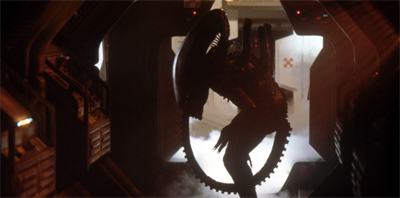
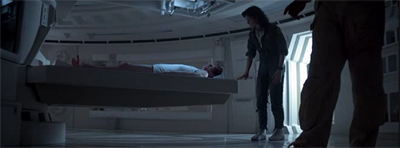

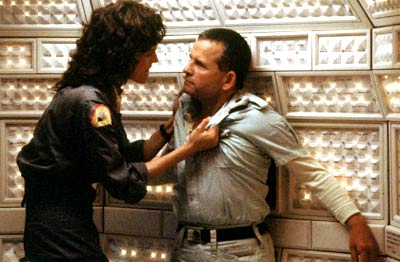
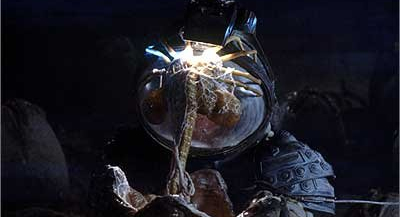
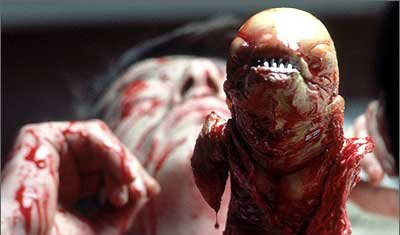


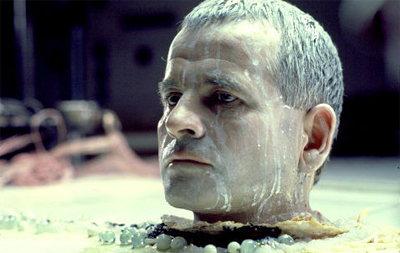
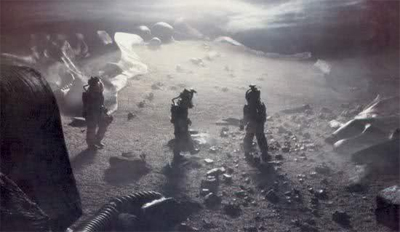





Very good article. “Alien” is one of my favorite movies, an it is richly layered. The funny thing is, Dan O’Bannon can take credit for all the subtext if he wants, but the screenplay is fairly simple and straight-forward. It was Ridley Scott’s directing, the acting, the art direction, and H.R. Giger’s creature design that really made the movie what it was. If the script was shot without these elements, it would have seemed like a derivative, schlocky horror/sci-fi film.
I also need to point out a couple things from the article. Why would Ripley’s having a daughter make her an adulterer if she slept with Dallas? Simply having a child doesn’t mean that she’s married. Also, several times you referred to Lambert as “Lampert.”
Fair point. As I pointed out, the child only comes into it in Aliens, and thus wasn’t a part of the original film. Her daughter’s surname is given as McClarent, which could indicate it was her father’s name, or could have been her own name she’d taken on marriage. I also figured that the child was raised by another parent, though it could be a friend or other relative. In fact, even if there was a father in the child’s life, it doesn’t mean he and Ripley are married or ever were. You’re right, it’s an assertion on very shaky ground. I just always felt that it played to the space-trucker thing, and liked the idea of Ripley as breadwinner in an inversion of the stereotypical gender roles of the time.
And I shall correct the spelling. Cheers!
Bravo! Just discovered your blogs, read a few, and believe you have the best insight since Roger Ebert — better, in many ways. And that is really saying something. I’ve always said I could learn at least as much from one of Roger’s reviews as from the film it was written about. I own many of his books and still binge-read them like novels.
About the Alien franchise: From my first viewing of Alien I felt there was an overriding theme almost too obvious to mention…and yet I’ve never seen it mentioned, anywhere. The real monster was the company, Weyland and, by inference, all of humanity. Ripley was not only extraordinarily intelligent, sensible and compassionate, but those qualities set her apart from the human race in general (as represented by the Nostromo crew). The other crew members were variously gifted and deficient — largely too much intelligence and too little imagination, notably Dallas (intelligence at the expense of imagination) and Lambert (intelligent enough but too much imagination; it has been
said of fearful/phobic people that they imagine all too vividly). One of Ripley’s greatest gifts was balance. Her seeming heroism was not due to “super powers;” she simply glowed by comparison to the lack of good qualities, and overall balance, in others.
But back to who the real monsters were. Ash admired the Aliens’ “purity.” Ripley commented that they didn’t screw each other over for a percentage. They conquered by brute force, not deception. You never had to wonder if they were friend or foe. And, even though they apparently would eat any and everything else, they didn’t eat each other. Unlike the human race, which enslaves and at least figuratively cannibalizes its own every chance it gets.
Lastly, the concept of the “Aliens” being a horrific species which, given the chance, would wipe out every other form of life it comes in contact with…well, if that idea were directed at humans it wouldn’t be the first time, and not entirely without merit.
It’s even noteworthy (if you trust the logic of the franchise) that once humans had samples of the Alien race under their complete control, they made no attempt to understand or communicate with them, but rather exploited and experimented on them. Especially Ripley 8, who arguably would have been the best hope for building a bridge. Even as a human/Alien hybrid, she still stood apart as something better than either or both.
So maybe in the long run, the “company” and “humanity” are the real monsters, and the rare individual (emphasis on “individual”) who can preserve both objectivity and compassion, is inevitably alienated — alone.
What a wonderful metaphor for the loneliness of enlightenment. Such food for thought.